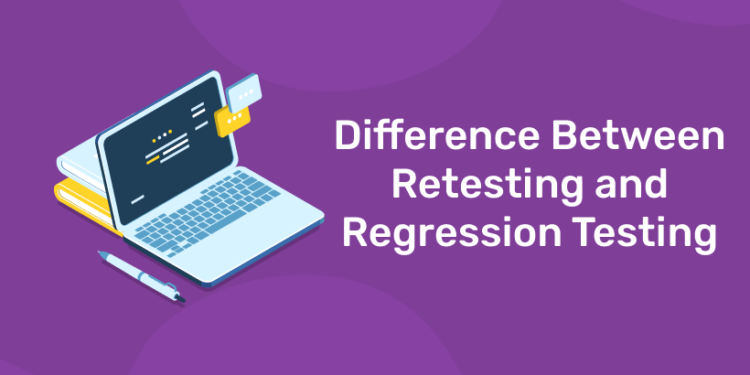Table of Contents
Software development’s primary objective is to ensure that a piece of software satisfies a need of the intended audience. To ensure customer satisfaction, it is essential that the application is dependable, and efficient, and delivers high-quality content. Therefore, software testing is one of the most crucial aspects of creating a product that consumers can rely on. Regression testing is essential for maintaining the quality of a program because it ensures that the code is still functional after modifications or updates have been made. Retesting verifies that the fixed flaws in the code are functional. To reiterate, it would be impossible to develop and maintain functional, high-quality software without exhaustive testing.
What is Retesting?
1: Which of the following algorithms is most suitable for classification tasks?
Since it is their responsibility to test software programs, test engineers frequently discover bugs while doing so. They then need to determine whether the bug has actually been fixed after giving the developers the duty of repairing these bugs. Retesting is the term for this. Retesting is the process of doing a test on a particular feature that was found to be inoperative during the prior test to verify its functionality. Let’s use an online store that sells phones as an example. The like button for the products wasn’t functioning, which was discovered during tests on the elements’ usability. The test engineer will assign the developer to fix the defect after identifying it. The test engineer would need to retest and determine whether this particular feature has been fixed and is operating as it should after the developer rolls back.
When to use Retesting?
- Retesting can be used to test a specific component in order to validate its functionality.
- It can also be used to assert or verify to the developer that a specific module or component is non-functional.
To summarize, retesting can be done for various reasons. However, the common purpose of any retest is to repeat a test and confirm the existence or non-existence of a particular defect.
What is Regression Testing?
It’s crucial to check for a butterfly effect when a developer introduces updates or modifications to the software. Regression testing uses a generalized method to seek these unintended faults because even a modest change in the application could cause them elsewhere. Regression testing is a type of testing whose goal is to confirm that no unintended regressions or defects have happened as a result of an application update or code change. Regression testing tries to perform a catch-all test to confirm that no unintended bugs have occurred in the application, whereas retesting aims to determine whether a specific bug has been fixed.
When to use Regression Testing?
- There is an update or enhancement carried out on the application.
- A defect found in the application is fixed.
Regression testing is carried out in CI/CD pipelines by repeating test cases that have already been run on an application, sometimes in their entirety. This sounds very similar to retesting, but retesting checks to see if specific known defects are fixed, whereas regression testing checks for unexpected application flaws.
Click here to know more about testing
Retesting vs Regression Testing
| Retesting | Regression Testing |
| Retesting includes tests made especially to determine whether already-known issues have been repaired. | Regression testing isn’t targeted testing for known defects. |
| Retesting aims to see if functionality has been reinstated after a bug fix rather than focusing on functionality from a previous version. | Regression testing is change-oriented and primarily checks whether the functionality of earlier versions of the application is preserved after a change or update to the application. |
| Since retesting checks for a specific defect, it can’t be automated. | Regression testing is a frequent application for automation. It would be absurd to manually test an application after each change or update. Automation is a much better complement than performing broad tests to look for unintended bugs. |
| Retesting is not a requirement for the testing procedure unless a bug is discovered and fixed; as a result, it is not a guarantee. | Regression testing is change-oriented and focuses on determining whether the functionality of earlier iterations of the application is still available following an update or change to the application. |
| A higher priority is applied to retesting since this kind of testing focuses on fixing known defects. | Regression testing is less important than Retesting because it only scans the application to look for potential unanticipated flaws. |
| Since only a certain defect is explored in retesting it is far less time-consuming. | Regression testing can take longer than retesting since it frequently probes extensive areas of the application to find flaws. |
Regression testing and retesting share a repetitive nature and appear to have a similar goal in an application, but as can be seen in the table, they are actually very different. Retesting is used to check for known bugs and to generally confirm that the bug in question has been fixed, which is the main distinction between retesting and regression testing. Regression testing is distinct from other types of testing because it looks for unknown bugs that may have appeared as a result of changes made to the application. Let’s examine an illustration to better illustrate the topic. Let’s imagine that when running a test, a software test engineer discovers a broken textbox that prohibits the user from signing in. The developer is contacted again to address the problem. The tester will next conduct another test to verify the functionality of that specific textbox.
Following this, a regression test will be run to look for more issues and make sure the fix has fixed everything. If other bugs are discovered during this test, they will be identified and sent back to the developer for fixing, and a new test will be conducted. Once the application passes the regression test and there are no longer any defects, another iteration will be performed. Retesting and regression testing frequently take place as part of the same testing procedure and are therefore complementary. But as was already shown, they serve different objectives. Regression testing is used to search the application for defects that may have developed from the change or other unknown residual bugs while retesting is used to verify that the initial bug, which was found and fixed, is functioning as it should.











